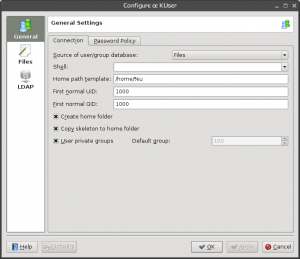User:BelaLugosi: Difference between revisions
Appearance
BelaLugosi (talk | contribs) No edit summary |
BelaLugosi (talk | contribs) No edit summary |
||
| Line 1: | Line 1: | ||
{{Template:I18n/Language Navigation Bar|KUser}} | {{Template:I18n/Language Navigation Bar|KUser}} | ||
::{|style="text-align:center" width="75%" | ::{|style="text-align:center" width="75%" | ||
|[[Image:System-users.png|128px|center]]|| '''KUser is a tool for managing users and groups on your system''' | |[[Image:System-users.png|128px|center]]|| '''KUser is a tool for managing users and groups on your system''' | ||
|} | |} | ||
{{info|'''Images are clickable, wich displays the full-size image. You have to use the back-button of you browser to return.'''}} | |||
== Features == | == Features == | ||
Revision as of 19:27, 13 January 2010
Template:I18n/Language Navigation Bar
Features
- Add/Edit/Remove users
- Add/Edit/Remove groups
- Password Management
Setup
Kuser usually is not installed by default, so it has to be installed manually. KUser is part of the kdeadmin-package. Once installed you can find it under K-Menu -> System -> KUser, or start it with KRunner (Alt+F2) typing 'kuser'.
Using KUser
After starting KUser a window opens containing two tabs: Users and Groups.

Users
Double-clicking a user opens a dialog with several tabs. The amount of tabs is variable, depending on the type of the user storage system and whether quotas are being used.
User Info
- Modify the userproperties like User-ID, Name, Adressinformations or set/change a password for example. You can also deactivate a account.

Password Management
- Change password settings, like the time after that a password have to be changed, or set a time a account will expire on.

Groups
- Add or remove groups the user belongs to.

Groups
Double clicking a group opens a dialog, where you can change the name of the group and add/remove users to/from a group.

Configure KUser
Click Help -> Configure KUser and you can set up defaults for creating a new user:
General
- set the shell, the home path or the UID.
- choose if a home folder will be created and if a skeleton (standard configuration files) will be copied to the home folder.
- set a private group, which creates a own personal group when a user is added and removes it, when the user is removed.
- set a standard password policy.

Files
- set default paths for password, group file, password shadow file and group shadow file.

LDAP
- set preferences for users in a local network



